 In Copenhagen, 1807 the British army under Lord Cathcart and the Royal Navy under Admiral Gambier cooperated to seize the Danish fleet to stop it falling into the hands of the French. Denmark was a neutral country and the bombardment of Copenhagen, although it achieved its aim, was not universally popular.
In Copenhagen, 1807 the British army under Lord Cathcart and the Royal Navy under Admiral Gambier cooperated to seize the Danish fleet to stop it falling into the hands of the French. Denmark was a neutral country and the bombardment of Copenhagen, although it achieved its aim, was not universally popular.
The army reserve was commanded by Sir Arthur Wellesley, keen to return to the field from his position as Chief Secretary in Ireland, and in An Unwilling Alliance a meeting of the various commanders brings together Captain Hugh Kelly, the Manx commander of the Iris and a young army major on the rise, serving under Sir Arthur Wellesley, Major Paul van Daan…
Hugh turned at a sudden noise from the stable yard. The commanders had left their horses in charge of a groom and the man had roped them to a long wooden bar outside the stables. There was no sign of him now but one of the horses, a solid piebald with knots in his mane and a thick neck, had broken loose from the rail and was backing up across the yard. His freedom was making the other horses restive and they were pulling on their tethers. Hugh swore softly under his breath and made his way outside.
Another man was ahead of him, one of the escort who had arrived with the army commanders. He was tall and fair, an officer in a red coat, his back to Hugh as he approached the piebald, placing himself between the horse and the way out of the yard. Hugh went to the bar where the other horses were tied and inspected the ropes. As he had suspected, every one of them was poorly tied, ready to be loosened with a determined tug. Hugh sighed and released the first of them, retying it.
The officer spoke, his voice a clear baritone which was hard to place. The accent spoke of privilege and wealth and the purchase of a commission but the phrasing and words were slightly unusual, as if this man had lived a varied life in many places.
“Stand still, you cross-eyed Danish bastard, I’m not chasing you halfway across the city because a groom can’t tie a knot. Come here.”
He caught the loose rein and then moved in confidently as the horse reared up in fright, putting a soothing hand on the ungroomed neck and running it down the horse’s shoulder. “All right lad, I know you’re scared. No need to be. Come on, let’s get you back where you should be and fed and watered. And by the look of you a brush wouldn’t go amiss. Come on.”
He was holding his body against the horse, steadying him, and the animal quietened immediately, soothed by the confidence in both voice and body. Hugh watched in reluctant admiration as the man turned, leading the horse back into the yard. He was wearing the insignia of a major and looked several years younger than Hugh with fair hair cut shorter than was fashionable, especially in the army or navy, and a pair of surprising blue eyes. The eyes rested on Hugh for a moment, then the major led the horse back to its place at the rail and began to tie him up. Hugh watched him in surprise for a moment, recognising the knot and then looked up into the major’s face.
“I doubt he’ll break away from that,” he said in matter-of-fact tones, moving on to re-tie the next horse.
The major did the same. “How to tie a knot that stays tied was one of the only two useful things the bloody navy taught me,” he responded, pleasantly.
“What was the other?” Hugh asked.
“How to kill people. I got very good at that.” The major tied the last knot and surveyed Hugh’s handiwork to ensure that it was properly done with an arrogance which both irritated and amused Hugh. Then the man looked up and saluted. “Major Paul van Daan, Captain, 110th first battalion. I’m here with Sir Arthur Wellesley.”
“Sir Arthur Wellesley might have been walking back to his lodgings if you’d not been as quick,” Hugh said, returning the salute. “You’d think a groom would be better at tying up horses, wouldn’t you?”
“A Danish groom, this week? What do you think, Captain?”
Hugh grinned. “I think a pack of British commanders having to walk through town because their hired horses have buggered off might be a small victory but very satisfying,” he said. “Captain Hugh Kelly of the Iris, Major. How did you end up in the army, then? Navy didn’t suit?”
“I was fifteen and I didn’t volunteer, Captain. Put me off a bit.”
Hugh shot him a startled glance. “Christ, you don’t sound like a man who ought to have been pressed.”
“They don’t always play by the rules. But it was definitely educational.”
“How long were you in?”
“Two years. Made petty officer, fought in a few skirmishes and at the Nile.”
Hugh felt his respect grow. “I was there myself,” he said. “Let me buy you a drink. They’ll be a while, I suspect. You on Wellesley’s staff?”
The major grinned. “Not officially, although he bloody thinks I am. Let me have a word with that groom and I’ll be with you.”
Hugh watched as he went to the stable door and yelled. The man emerged at a run and stood before Van Daan, his eyes shifting to the neatly tied horses in some surprise. He looked back at the major, his expression a combination of guilt and defiance.
Van Daan reached out, took him by one ear, and led him to the horses as if he had been a misbehaving schoolboy. He indicated the newly tied knots, spoke briefly and then clipped the groom around the head, not very hard. Hugh saw him point to the feed troughs and water pump, using gestures to make up for the language difficulties. He then pointed to the piebald’s tangled mane and muddy coat and gestured again. The groom was nodding, his sulky expression lightening a little.
Having given his orders, something with which Hugh observed sardonically that Paul van Daan seemed very comfortable, the young major reached into his coat pocket and took out two coins which he held up. The groom’s eyes fixed on them and Paul van Daan pointed to the horses and spoke again. The man nodded. The major handed him one coin and put the other back into his pocket. Then he smiled, the first real smile Hugh had seen him give, and it transformed his face. The groom smiled back as though he could not help it, and the major put his hand on the man’s shoulder, laughed, and then ruffled the dirty hair with surprising informality as if he were a younger brother or cousin. He released the groom and went to the ugly piebald horse, stroking his neck. The animal nuzzled his shoulder and Van Daan smiled, reached into his pocket and took out a treat. He stroked the horse as he fed it and Hugh watched him and wondered if the small drama he had just watched played out was regularly enacted with Van Daan’s men. If it was, he suspected the man was an asset to the army.
“Major van Daan!”
The voice was cold, clipped, it’s tone biting, coming from an upstairs window of the inn, the room where the commanders were dining. Van Daan turned and looked up.
“Is there a reason why you are in the stable yard socialising with the grooms when the man I have sent to search for you is combing this establishment looking for you? Or are you under the impression that I asked you to accompany me in order to give you a day off?”
Major Paul van Daan saluted with a grin to the upstairs windows where the dark head of Sir Arthur Wellesley protruded. “Sorry, sir, didn’t think you’d need me for a bit.”
“It appears that the secretary provided speaks very little English and I would prefer to have this meeting fully documented in a language that the cabinet in London understands. Sir Home Popham appears to be of the opinion that no minutes are needed at all which makes me all the more determined to provide them. Try to write legibly for once.”
“On my way, sir,” Van Daan said. Wellesley withdrew his head and the major gave one more nut to the piebald, called a word to the groom who was filling water buckets with considerable speed and joined Hugh at the door. “I’m sorry, Captain, we’ll need to postpone that drink, it appears I am now a secretary as well as a battalion commander. Thanks for your help with the horses.”
“You’re welcome,” Hugh said. “You in trouble, Major?”
“Wellesley? Jesus, no, that’s him on a good day,” Van Daan said, laughing. “I’d better go before he causes serious offence. Good afternoon.”
An Unwilling Alliance is due for publication in April 2018. An Unconventional Officer, telling the story of Paul van Daan and the 110th infantry is available on Amazon.

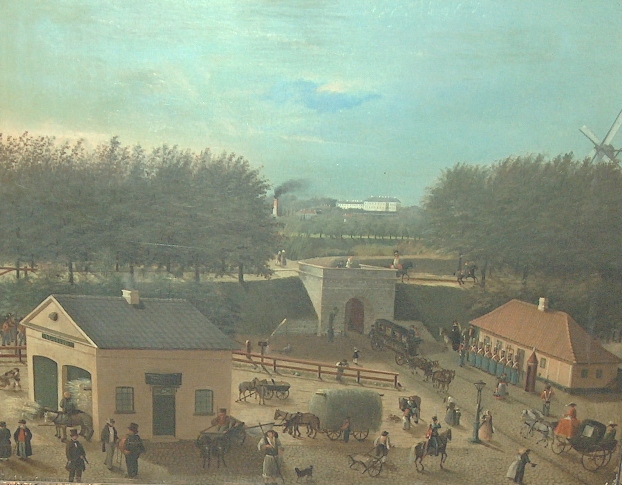
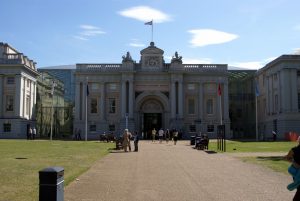
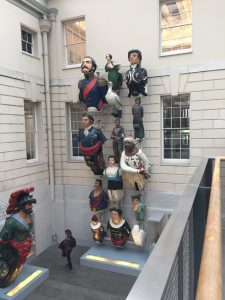 The gallery concerned with traders explores the relationship between Britain and the wider world, particularly the powerful East India Company which spread its influence until it controlled huge areas of territory in India. I found this fascinating, partly because I studied this at University and partly because I spent time researching the Company in India when I was writing about Assaye in
The gallery concerned with traders explores the relationship between Britain and the wider world, particularly the powerful East India Company which spread its influence until it controlled huge areas of territory in India. I found this fascinating, partly because I studied this at University and partly because I spent time researching the Company in India when I was writing about Assaye in 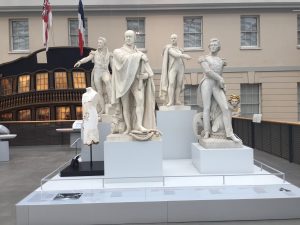 Other galleries explored the maritime history of London, the first world war and in Voyagers, the personal significance of Britain’s maritime story. I particularly liked the exploration of Turner’s famous painting of Trafalgar which analysed the painting and it’s meaning in the context of national pride and naval power following the battle.
Other galleries explored the maritime history of London, the first world war and in Voyagers, the personal significance of Britain’s maritime story. I particularly liked the exploration of Turner’s famous painting of Trafalgar which analysed the painting and it’s meaning in the context of national pride and naval power following the battle.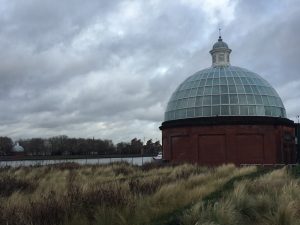 We used to take the bus to the Isle of Dogs back in the sixties and seventies and then walk through the foot tunnel to Greenwich. The foot tunnel is a piece of history in itself, a masterpiece of late Victorian engineering which opened in 1902 and was built to replace an expensive and unreliable ferry service which took workers living south of the river to work in the docks and shipyards. The entrances at each end are beneath glazed domes and I can remember the joy of running through the tunnel calling out and hearing my voice echo, bouncing off the walls eerily. We used to count the steps at each end. There were lifts but for some reason we seldom used them.
We used to take the bus to the Isle of Dogs back in the sixties and seventies and then walk through the foot tunnel to Greenwich. The foot tunnel is a piece of history in itself, a masterpiece of late Victorian engineering which opened in 1902 and was built to replace an expensive and unreliable ferry service which took workers living south of the river to work in the docks and shipyards. The entrances at each end are beneath glazed domes and I can remember the joy of running through the tunnel calling out and hearing my voice echo, bouncing off the walls eerily. We used to count the steps at each end. There were lifts but for some reason we seldom used them.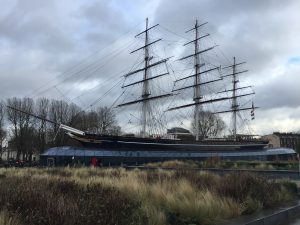 A visit to Greenwich is both a research aide for the new book and a trip down memory lane. The strong sense of standing with both feet in maritime history is just what I need as I embark on the second half of my book which places me aboard a Royal navy ship bound for Copenhagen in 1807 under Admiral Gambier. But there is also a sense of standing with at least one foot in my own past, a child growing up in the East End with parents who took us to some historic site almost every weekend. There is a strong link between that excited little girl standing on the deck of an old ship and trying to imagine how it felt to sail in her and the woman writing a novel of those who did. I owe that as a debt to the parents who gave me that sense of history and why it matters to all of us.
A visit to Greenwich is both a research aide for the new book and a trip down memory lane. The strong sense of standing with both feet in maritime history is just what I need as I embark on the second half of my book which places me aboard a Royal navy ship bound for Copenhagen in 1807 under Admiral Gambier. But there is also a sense of standing with at least one foot in my own past, a child growing up in the East End with parents who took us to some historic site almost every weekend. There is a strong link between that excited little girl standing on the deck of an old ship and trying to imagine how it felt to sail in her and the woman writing a novel of those who did. I owe that as a debt to the parents who gave me that sense of history and why it matters to all of us.